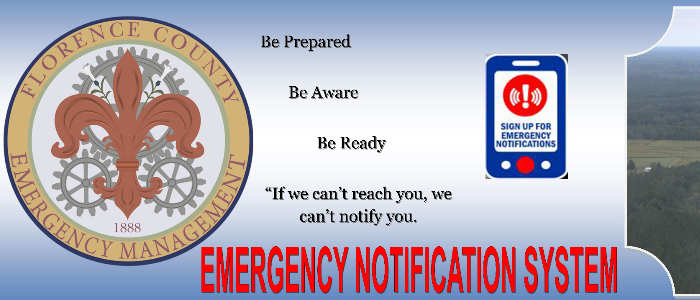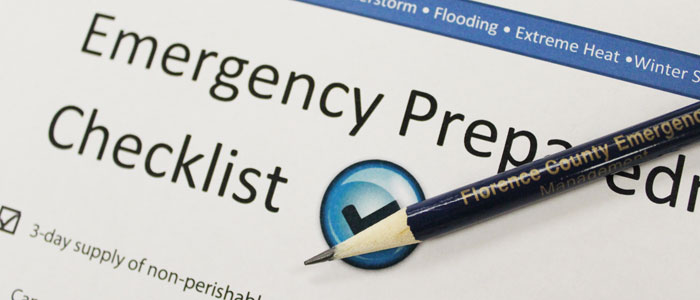Emergency Operations Plan
It is the policy of Florence County government to be prepared for any emergency or disaster. Florence County government will establish policies and procedures to help minimize the loss of life, prevent damage to property, protect the environment and provide assistance to all people and institutions that are victims of disaster.
MISSION STATEMENT: In regard to emergency operations, Florence County government has 5 primary missions:
1. To take all actions possible to mitigate, prepare for and respond to the consequences of a disaster within the county.
2. To warn citizens of impending danger and inform them how they can protect themselves, their families and their property.
3. To assess the situation and determine prioritization of critical needs.
4. To manage the disaster situation and coordinate the utilization of county, state and federal resources in an effective and timely manner.
5. To coordinate the recovery of the county and the restoration of the community to a level better than it was prior to the disaster.
*Some Annexes of the EOP are not included on the website for security reasons due to the sensitive nature and content.*
|
TABLE OF CONTENTS |
BASIC PLAN |
ANNEX 1 |
ANNEX 2 |
|
ANNEX 2 App C |
ANNEX 3 |
ANNEX 4 |
ANNEX 5 |
|
ANNEX 6 |
ANNEX 7 |
ANNEX 8 |
Annex 10 |
|
ANNEX 13 |
ANNEX 14 |
Annex 14 Att E |
ANNEX 15
|
|
ANNEX 17 |
ANNEX 18 |
ANNEX 25 |
|
Plan for Pets
Our pets are important members of our families. Just like all members of a family, it is important to include them in our disaster preparation plans. The likelihood of a pet surviving a disaster depends largely on the planning done before a disaster occurs. The following steps will help to ensure you and your pets are ready if a disaster were to strike.
Before
Assemble an animal emergency supply kit in the event you have to evacuate your home for an emergency. This kit should contain:
- Water. At least three days of water specifically for your pets;
- Food. Three days of food in an airtight, waterproof container;
- Medications;
- Pet first aid kit. Talk to your veterinarian about what is most appropriate for your pet’s emergency medical needs;
- Collar with ID tag, harness or leash;
- Crate or other pet carrier;
- Sanitation materials to provide for your pet’s sanitation needs- litter box, newspapers, paper towels, garbage bags;
- A picture of you and your pet together in case you should be separated from your pet during an emergency; and
- Familiar items like toys or treats that may help reduce stress for your pet.
If you have to evacuate from your home, take your pet with you – you are responsible for the care of your pet! Most emergency shelters will not accept pets (with the exception of service animals) due to health reasons. Know which hotels in the area you plan to evacuate to. Choose a hotel that allows pets. If you plan to stay with family members or friends, be sure they can accommodate pets.
Some counties are planning temporary emergency animal shelter facilities, but not all are in place and should only be used as a last resort. Call your local emergency management office, animal shelter or veterinarian to get advice and information on boarding your pet. Many of these facilities require your pet’s medical records. Make sure all vaccinations are current.
Contact your county emergency manager if they need to be aware of special needs you may have, such as assistance with evacuation if you possess a guide dog or other service animal. Service animals are allowed on all means of public transportation and in all human shelters.
If you must leave your pet at home, provide access to someone in advance so they can check in. Choose and use an ID method for each animal- micro-chipping, ID tags on collar, photos of you with your animal. This is extremely important if your animals become lost. Confine your pet to a safe area inside -- NEVER leave your pet chained outside! Leave them loose inside your home with food and plenty of water. Remove the toilet tank lid, raise the seat and brace the bathroom door open so they can drink. Place a notice outside in a visible area, advising what pets are in the house and where they are located. Provide a phone number where you or a contact can be reached as well as the name and number of your veterinarian.
During
If you are unable to evacuate with your pets, bring them inside immediately. Have newspapers on hand for sanitary purposes. Feed the animals moist or canned food so they will need less water to drink.
Animals have instincts about severe weather changes and will often isolate themselves if they are afraid. Bringing them inside early can stop them from running away. Never leave a pet outside or tied up during a storm. Separate dogs and cats. Even if your dogs and cats normally get along, the anxiety of an emergency situation can cause pets to act irrationally. Keep small pets away from cats and dogs.
After
In the immediate post-incident period the focus for emergency workers will be human safety. When circumstances allow, there will be personnel trained in animal emergencies integrated into the local incident management structure to assist emergency workers and citizens with animal needs. These may include “rescue” (capture and transport to safety) of displaced animals, identification, treatment, temporary shelter and care, and reunification with owners.
In the first few days after a disaster, leash your pets when they go outside. Always maintain close contact. Familiar scents and landmarks may be altered and your pet may become confused and lost. Check your yard for downed power lines, debris and displaced wildlife.
The behavior of your pets may change after an emergency. Normally quiet and friendly pets may become aggressive or defensive. Watch animals closely. Leash dogs and place them in a fenced yard with access to shelter and water.
Hazard Mitigation Plan
Hazard Mitigation Plan Documents:
01 - Introduction
02 - Planning Process
03 - Community Profile
04 - Hazard ID and Risk Assessment
05 - Plan Implementation
06 - Goals and Objectives
07 - Mitigation Initiatives
Appendix A - Florence County Stakeholders
Appendix B - Stakeholders Invite and Sign In Sheet
Appendix C - Notice of Pu blic Meeting and Screen Shot
Appendix D - Public Meeting and Sign In Sheet
Appendix E - Florence County Questionnaire and Distribution List
Florence Co. SC APA Letter 01-31-2020
Resolution No. 21-2020 - HazMitPlan
The Disaster Mitigation Act of 2000, also known as DMA 2000 was signed into law on October 30, 2000 by the President. This established a requirement that to remain eligible for federal funds, local and state governments must develop and adopt an approved hazard mitigation plan. The Federal Emergency Management Agency (FEMA) published an Interim Final Rule (IFR) on February 26, 2002. This set the guidance and regulations under which such plans are to be developed. It includes the planning process as well as the contents of the plan that are required.
Hazard mitigation is often defined as actions taken to reduce the effects of natural hazards on a place and its population. This plan focuses on the countywide hazards with the highest potential for damaging physical assets, people and operations in Florence County. Both the risk assessment and mitigation action plan sections reflect this emphasis, which was the result of careful consideration and a ranking process carried out by the Florence County Hazard Mitigation Planning Committee (FCHMPC). This committee was formed and staffed by the Florence County Emergency Management Department and the Florence County Planning Department. The committee was charged with developing a county component for the plan. Neighboring communities, agencies involved in hazard mitigation and businesses, academia, and other relevant private and non-profit interests were also involved in the planning process. All towns and cities as well as representatives from law enforcement, emergency services, business and industry and others with interest in hazard mitigation planning were invited to participate in the development of the respective county components of the plan.
The FCHMPC reviewed existing plans, studies, reports and technical information. Documents reviewed included comprehensive plans, zoning ordinances, building codes, historical hazard event records, and emergency operations plans. Recommendations in these documents relative to hazard mitigation issues were addressed in the hazard vulnerability analysis and hazard mitigation initiatives prepared for inclusion in this plan. Additionally, public meetings were scheduled to provide an opportunity for the general public and local government officials to have input. This was accomplished by public meetings conducted in Florence County. The meetings were coordinated by the Florence County Emergency Management Department and the Florence County Planning Department in cooperation with administrative officials from each participating municipality. The public was invited to the meetings through news releases and notices posted at municipal and county offices.
Florence County Emergency Management and Florence County Planning assisted the county planning committee in conducting detailed studies to identify the hazards threatening the jurisdictions of Florence County and to estimate the relative risks posed to the community by those hazards. This information has been used by the committee to prioritize their planning efforts to assess the vulnerabilities of the facilities and neighborhoods of Florence County to the
impacts of future disasters involving those hazards. With these vulnerabilities identified, the committee worked to identify, justify and prioritize specific proposals for projects and programs that will avoid or minimize these vulnerabilities. This document includes a detailed characterization of hazards in Florence County; a risk assessment that describes potential losses to physical assets, people, and operations; a set of goals, objectives, strategies, and initiatives that will guide Florence County mitigation activities; and a detailed plan for implementing and monitoring the plan.
These proposed projects and programs to reduce the impacts of future disasters are called “mitigation initiatives” in this document. Mitigation initiatives have been developed, and will continue to be developed, by the county planning committee for implementation whenever the resources and opportunities to do so become available. Implementation of this plan is essentially through implementation of the mitigation initiatives included in the plan, and with each implementation effort, the county planning committee will continue to help make the participating communities more resistant to the human and economic costs of future disasters.
This document details the work of the Hazard Mitigation Planning Committee over the past several months to develop the planning organization, to undertake the needed technical analyses, and to coordinate the mitigation initiatives that have been proposed by the participating jurisdictions and organizations. The draft plan will be submitted to all participating jurisdictions for adoption by the respective governing bodies.
The Florence County Hazard Mitigation Plan has been established to make the population, neighborhoods, businesses and institutions of the community more resistant to the impacts of future disasters. The county planning committee and staff have been undertaking a comprehensive, detailed evaluation of the vulnerabilities of the towns, cities and unincorporated areas throughout the county to all types of future natural hazards in order to identify ways to make the communities of the planning area more resistant to their impacts. This document reports the results of that planning process for the current planning period.
Plan for Your Business Industry
It’s important for businesses to plan and prepare for a hurricane or any emergency that could affect normal operations and employees. Businesses located along the South Carolina coast are not the only ones that could be affected by a hurricane or any other tropical storm system. Inland businesses could be affected by these storms if coastal businesses and suppliers have to stop production or temporarily close.
Business owners should develop a recovery plan for their business by taking the following precautions:
- Include emergency preparedness information in company newsletters, company intranet, employee emails or other company communication tools.
- Consider a telephone calling tree or a voice recording to communicate with employees during an emergency.
- Designate an out-of-town number where employees can leave an, “I’m okay” message during a catastrophic disaster.
- If you have employees with disabilities or functional needs, talk with them about what their needs may be during a disaster.
- Plan for payroll continuity.
- Review and practice what you and your employees intend to do during and after an emergency.
- Establish facility shutdown procedures.
- Establish warning and evacuation procedures.
- Make plans for assisting employees who may need transportation.
- Make plans for communicating with employees' families before and after a hurricane.
- Purchase a NOAA Weather Radio with a warning alarm tone and battery backup.
- Survey your facility. Make plans to protect outside equipment and structures.
- Check if your phone system will work without electricity. If not, have at least one phone line that can operate without electricity.
- Make plans to protect windows. Permanent storm shutters offer the best protection. Covering windows with plywood is a second option.
- Consider the need for backup systems such as portable pumps to remove floodwater and generators to provide emergency power.
- Prepare to move records, computers and other items within your facility or to another location.
- Consider how to recover any digital data if there is a significant power outage or if computers and servers are damaged. Keep tax and payroll records, records of inventory and essential information at an alternate site.
- Establish an alternate operating location and back-up suppliers.
- Maintain three to five days of inventory. If a disaster occurs, the loss isn’t as great.
Disaster Kit
It is important to keep enough supplies in your home to meet the needs of your family for at least three days. Assemble a Family Emergency Kit with items you may need in an emergency or evacuation. Store these supplies in sturdy, easy-to-carry containers such as suitcases, duffle bags or covered storage containers.
Include at a minimum:
- Water, two gallons of water per person per day for at least three days, for drinking and sanitation
- Food, at least a three-day supply of non-perishable food
- Battery-powered or hand crank radio and a NOAA Weather Radio with tone alert and extra batteries for both
- Flashlight and extra batteries
- First aid kit
- Whistle to signal for help
- Moist towelettes, garbage bags and plastic ties for personal sanitation
- Wrench or pliers to turn off utilities
- Manual can opener for food (if kit contains canned food)
- Local maps
- Cell phone with chargers
- Prescription medications and glasses
- Infant formula and diapers
- Pet food and extra water for your pet
- Important family documents such as copies of insurance policies, identification and bank account records in a waterproof, portable container
- Family emergency contact information
- Cash or traveler's checks and change
Additional items to consider include
- Sleeping bag or warm blanket for each person. Consider additional bedding if you live in a cold-weather climate.
- Complete change of clothing including a long sleeved shirt, long pants and sturdy shoes. Consider additional clothing if you live in a cold-weather climate.
- Fire extinguisher
- Multipurpose tool
- Matches in a waterproof container
- Duct tape
- Dust mask to help filter contaminated air
- Feminine supplies and personal hygiene items
- Mess kits, paper cups, plates and plastic utensils, paper towels
- Paper and pencil
- Books, games, puzzles or other activities for children
Water
- Store water in plastic containers such as soft drink bottles or plastic milk jugs.
- Avoid using containers that will break, such as glass bottles.
- A normally active person needs to drink at least two quarts of water each day. Hot environments and intense physical activity can double that amount. Children, nursing mothers and ill people will need more.
- Store two gallons of water per person per day (one gallon for drinking, one gallon for food preparation/sanitation)
- Keep at least a three-day supply of water for each person in your household.
Food
- Store at least a three-day supply of non-perishable food.
- Select foods that require no refrigeration, little preparation or cooking and little or no water.
- Select food items that are compact and lightweight.
- Ready-to-eat canned meats, fruits and vegetables
- Canned juices, milk, soup (if powdered, store extra water)
- Staples--sugar, salt, pepper
- High energy foods--peanut butter, jelly, crackers, granola bars, trail mix
- Vitamins
- Foods for infants, elderly persons or persons on special diets
- Comfort/stress foods--cookies, hard candy, sweetened cereals, lollipops, instant coffee, tea bags
First Aid Kit
Assemble a first aid kit for your home and one for each car. Contact your local American Red Cross chapter to obtain a basic first aid manual. Each first aid kit should include:
- 2-inch sterile gauze pads (4-6)
- 4-inch sterile gauze pads (4-6)
- Hypoallergenic adhesive tape
- Triangular bandages (3)
- 2-inch sterile roller bandages (3 rolls)
- 3-inch sterile roller bandages (3 rolls)
- Scissors
- Tweezers
- Needle
- Moistened towelettes
- Antiseptic
- Thermometer
- Tongue blades (2)
- Tube of petroleum jelly or other lubricant
- Assorted sizes of safety pins
- Cleansing agent/soap
- Latex gloves (2 pair)
- Sunscreen
Suggestions and Reminders
- Store your kit in a convenient place known to all family members. Keep a smaller version of the Family Emergency Kit in the trunk of your car.
- Keep items in air-tight plastic bags.
- Change your stored water supply every six months so it stays fresh.
- Rotate your stored food every six months.
- Re-evaluate your kit and family needs at least once a year. Replace batteries, update clothes, etc.
- Ask your physician or pharmacist about storing prescription medications.






